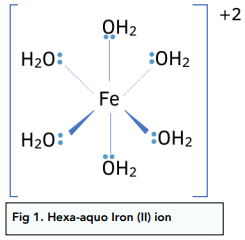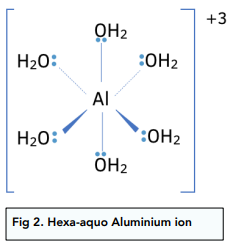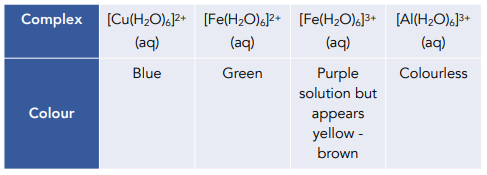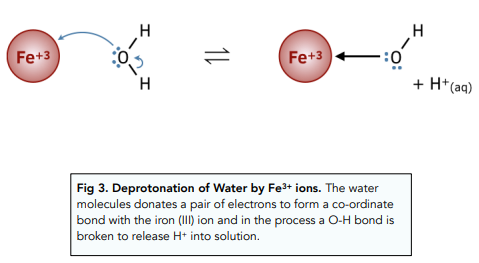Reactions of Ions in Aqueous Solutions - Metal Ions in Solution (A-Level Chemistry)
Metal Ions in Solution
M²⁺(aq) and M³⁺(aq) Metal-aqua Ions
When a transition metal salt is dissolved in water an aqueous solution is formed. The transition metals produce complex ions with water.
These complex ions are called metal-aqua ions.
Six water molecules form co-ordinate bonds with central metal ions, forming octahedral complexes, with a co-ordination number of six.
The overall charge of the metal-aqua complex is the same as the transition metal at the centre.
For example, iron (II) nitrate in solution will form the metal-aqua ion below:

Other metals also form metal-aqua ions. Aluminium is an example. In Al³⁺ ions, the electron configuration is 1s2²s2²p⁶.
One 3s, a 3p and two of the 3d orbital hybridise to produce six new orbitals of equal energy.
These orbitals are used to form co-ordinate bonds with six water molecules.
Aluminium (III) salts, when dissolved, will form the following metal-aqua ion:

The reactions of metal-aqua ions you need to be familiar with are as follows:

Acidity in Metal-Aqua 2+ Ions
Solutions of metal-aqua 2+ ions containing Fe²⁺ and Cu² ions hydrolyse in water.
H+ ions are removed from the water ligands making solutions containing these metal-aqua ions slightly acidic.
The reason this occurs, is because the Fe² ions or Cu² ions attract the lone pair of electrons of some of the water molecules.
This weakens one of the H-O-H bonds of a water molecule, and the H+ ion is removed into solution.
[Fe(H₂O)₆]²⁺(aq) + H₂O(l) ⇌ [Fe(OH)(H₂O)₅]⁺(aq) + H₃O⁺(aq)
[Cu(H₂O)₆]²⁺(aq) + H₂O(l) ⇌ [Cu(OH)(H₂O)₅]⁺(aq) + H₃O⁺(aq)
There is only slight hydrolysis, so the solution is weakly acidic.
Acidity in Metal-Aqua 3+ Ions
In metal aqua 3+ ions containing Fe³⁺ and Al³⁺ ions, the charge density, or charge/size ratio, on the central metal ion is much higher.
This is because:
- the ion is smaller than the 2+ ion
- there is a greater charge on the 3+ ion than the 2+ ion
This makes the metal 3+ ion much more polarising than the metal 2+ ion.
Metal 3+ ions attract electrons from the oxygen atoms more easily and more O-H bonds are weakened, releasing H⁺ ions more easily.
[Al(H₂O)₆]³⁺(aq) + H₂O(l) ⇌ [Al(OH)(H₂O)₅]²⁺(aq) + H₃O⁺(aq)
[Al(OH)(H₂O)₅]²⁺(aq) + H₂O(l) ⇌ [Al(OH)₂(H₂O)₄]⁺(aq) + H₃O⁺(aq)
The same occurs for Fe³⁺ metal-aqua ions:
[Fe(H₂O)₆]³⁺(aq) + H2O(l) ⇌ [Fe(OH)(H₂O)₅]²⁺(aq) + H₃O⁺(aq)
[Fe(OH)(H₂O)₅]²⁺(aq) + H₂O(l) ⇌ [Fe(OH)₂(H₂O)₄]⁺(aq) + H₃O⁺(aq)






Still got a question? Leave a comment
Leave a comment